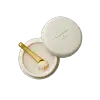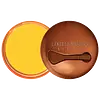What's inside
What's inside
 Key Ingredients
Key Ingredients

 Benefits
Benefits

 Concerns
Concerns

 Ingredients Side-by-side
Ingredients Side-by-side

Polyglyceryl-2 Triisostearate
EmulsifyingCaprylic/Capric Triglyceride
MaskingSqualane
EmollientMica
Cosmetic ColorantButyrospermum Parkii Oil
EmollientHelianthus Annuus Seed Wax
Skin ConditioningPhytosteryl/Octyldodecyl Lauroyl Glutamate
Skin ConditioningDimer Dilinoleyl Dimer Dilinoleate
EmollientSilica
AbrasiveOpuntia Ficus-Indica Seed Oil
EmollientDisteardimonium Hectorite
StabilisingEuphorbia Cerifera Wax
Ceramide NP
Skin ConditioningPalmitoyl Tripeptide-1
Skin ConditioningOpuntia Ficus-Indica Leaf Cell Extract
Skin ProtectingHibiscus Syriacus Callus Extract
AntioxidantRutin
AntioxidantSodium Hyaluronate
HumectantTocopherol
AntioxidantRosa Canina Fruit Oil
EmollientHydrolyzed Collagen
EmollientTribehenin
EmollientHelianthus Annuus Seed Oil
EmollientButylene Glycol
HumectantEthylhexyl Palmitate
EmollientSorbitan Isostearate
EmulsifyingPolyglyceryl-2 Triisostearate, Caprylic/Capric Triglyceride, Squalane, Mica, Butyrospermum Parkii Oil, Helianthus Annuus Seed Wax, Phytosteryl/Octyldodecyl Lauroyl Glutamate, Dimer Dilinoleyl Dimer Dilinoleate, Silica, Opuntia Ficus-Indica Seed Oil, Disteardimonium Hectorite, Euphorbia Cerifera Wax, Ceramide NP, Palmitoyl Tripeptide-1, Opuntia Ficus-Indica Leaf Cell Extract, Hibiscus Syriacus Callus Extract, Rutin, Sodium Hyaluronate, Tocopherol, Rosa Canina Fruit Oil, Hydrolyzed Collagen, Tribehenin, Helianthus Annuus Seed Oil, Butylene Glycol, Ethylhexyl Palmitate, Sorbitan Isostearate
Caprylic/Capric Triglyceride
MaskingCamellia Japonica Seed Oil
EmollientSimmondsia Chinensis Seed Oil
EmollientGarcinia Indica Seed Butter
Skin ConditioningOctyldodecanol
EmollientJojoba Esters
EmollientLauroyl Lysine
Skin ConditioningHelianthus Annuus Seed Wax
Skin ConditioningButyrospermum Parkii Butter
Skin ConditioningHelianthus Annuus Seed Oil
EmollientSqualane
EmollientDibutyl Ethylhexanoyl Glutamide
Skin ConditioningDibutyl Lauroyl Glutamide
Skin ConditioningSilica
AbrasiveHippophae Rhamnoides Fruit Oil
Skin ProtectingSodium Hyaluronate
HumectantCentella Asiatica Leaf Extract
Skin ConditioningTanacetum Annuum Flower Oil
MaskingCamellia Sinensis Leaf Powder
ExfoliatingSpirulina Platensis Extract
Skin ProtectingHoya Lacunosa Flower Extract
Skin ConditioningOpuntia Ficus-Indica Extract
Skin ConditioningGlucomannan
Skin ConditioningAcacia Decurrens Flower Wax
EmollientPrunus Amygdalus Dulcis Oil
Skin ConditioningTocopheryl Acetate
AntioxidantTrihydroxystearin
Skin ConditioningEthylhexyl Palmitate
EmollientPolyglycerin-3
HumectantHydrogenated Vegetable Oil
EmollientCaprylic/Capric Triglyceride, Camellia Japonica Seed Oil, Simmondsia Chinensis Seed Oil, Garcinia Indica Seed Butter, Octyldodecanol, Jojoba Esters, Lauroyl Lysine, Helianthus Annuus Seed Wax, Butyrospermum Parkii Butter, Helianthus Annuus Seed Oil, Squalane, Dibutyl Ethylhexanoyl Glutamide, Dibutyl Lauroyl Glutamide, Silica, Hippophae Rhamnoides Fruit Oil, Sodium Hyaluronate, Centella Asiatica Leaf Extract, Tanacetum Annuum Flower Oil, Camellia Sinensis Leaf Powder, Spirulina Platensis Extract, Hoya Lacunosa Flower Extract, Opuntia Ficus-Indica Extract, Glucomannan, Acacia Decurrens Flower Wax, Prunus Amygdalus Dulcis Oil, Tocopheryl Acetate, Trihydroxystearin, Ethylhexyl Palmitate, Polyglycerin-3, Hydrogenated Vegetable Oil
Ingredients Explained
These ingredients are found in both products.
Ingredients higher up in an ingredient list are typically present in a larger amount.
This ingredient is an emollient, solvent, and texture enhancer. It is considered a skin-softener by helping the skin prevent moisture loss.
It helps thicken a product's formula and makes it easier to spread by dissolving clumping compounds.
Caprylic Triglyceride is made by combining glycerin with coconut oil, forming a clear liquid.
While there is an assumption Caprylic Triglyceride can clog pores due to it being derived from coconut oil, there is no research supporting this.
Learn more about Caprylic/Capric TriglycerideEthylhexyl Palmitate, also known as octyl palmitate, is created from 2-ethylhexyl alcohol and palmitic acid. It is a fatty acid ester.
The fatty acid content of Ethylhexyl Palmitate makes it an emollient. Emollients help soften and hydrate your skin by trapping moisture within.
Ethylhexyl Palmitate is also used to help improve the texture of cosmetics. It helps other ingredient dissolve in products and help disperse ingredients more evenly.
You'll likely find this ingredient in sunscreen, as it is often used to mix UV-blocking ingredients such as avobenzone and ethylhexyl triazone.
It can also help stabilize the fragrances in a product as a fragrance fixative.
Ethylhexyl Palmitate can be used to substitute mineral oil.
Due to its high fatty acid content, it may not be fungal-acne safe.
Learn more about Ethylhexyl PalmitateHelianthus Annuus Seed Oil is the oil derived from the seeds of a Sunflower. Sunflower seed oil is non-fragrant. It is an emollient, meaning it helps to soften the skin.
Sunflower seed oil contains many fatty acids. The fatty acids found in sunflower seeds include (from highest amount to least): linoleic acid, myristic acid, palmitic acid, stearic acid, arachidic acid, oleic acid, and linolenic acid.
These fatty acids help the skin create ceramides. Ceramides play a role in repairing the skin barrier.
Helianthus Annuus Seed Oil helps moisturize the skin. This in turn helps the skin look more rejuvenated and smoother.
Sunflowers are rich in vitamin E.
Historians believe Indigenous cultures of North America domesticated sunflowers before corn. Thus they relied on sunflower oil for a variety of uses. One such use is moisturizing skin and hair.
Sunflower seed oil may not be fungal acne safe. We recommend speaking with a professional if you have any concerns.
Learn more about Helianthus Annuus Seed OilHelianthus Annuus Seed Wax is created from the common sunflower.
Sunflower seed wax is made up of long chain non-glyceride esters, a small amount of fatty alcohols, and fatty acids.
This ingredient is often used to enhance the texture of products. The fatty acid properties also help hydrate the skin.
Learn more about Helianthus Annuus Seed WaxSilica, also known as silicon dioxide, is a naturally occurring mineral. It is used as a fine, spherical, and porous powder in cosmetics.
Though it has exfoliant properties, the function of silica varies depending on the product.
The unique structure of silica enhances the spreadability and adds smoothness, making it a great texture enhancer.
It is also used as an active carrier, emulsifier, and mattifier due to its ability to absorb excess oil.
In some products, tiny microneedles called spicules are made from silica or hydrolyzed sponge. When you rub them in, they lightly polish away dead skin layers and enhance the penetration of active ingredients.
Learn more about SilicaSodium Hyaluronate is hyaluronic acid's salt form. It is commonly derived from the sodium salt of hyaluronic acid.
Like hyaluronic acid, it is great at holding water and acts as a humectant. This makes it a great skin hydrating ingredient.
Sodium Hyaluronate is naturally occurring in our bodies and is mostly found in eye fluid and joints.
These are some other common types of Hyaluronic Acid:
Learn more about Sodium HyaluronateSqualane is an emollient that helps the skin hold onto moisture. It's an oily liquid that occurs naturally in certain types of fish and plant oils.
Because squalane boosts hydration in the skin, it also comes with plenty of benefits: it is an antioxidant and can help fight free radicals and skin damage. Squalane is also found to have a detoxifying effect when applied.
Squalane comes from squalene, which occurs naturally within the sebum of our skin. It is one of the oils our skin produces to keep itself hydrated. Squalane is the hydrogenated version of squalene and has a longer shelf life.
Research shows that squalane is non-irritating (even at 100% concentration).
In general, it's a fantastic ingredient. It does a great job at hydrating the skin, and it's suitable for those with sensitive skin.
The source of squalane may impact malassezia / fungal acne. This is because olive oil derived squalane can contain impurities such as fatty acids and plant waxes. Sugarcane derived squalane is recommended for anyone with malassezia concerns.
Is squalane vegan?
This depends on the source. Squalane can be derived from both plants and animals. Most squalane used in skincare comes from plants.
Please note: the source of squalane is only known if disclosed by the brand. We recommend reaching out to the brand if you have any questions about their squalane.
Read more about squalene with an "e".
Is squalane an oil?
Squalane is often called an oil, but it’s technically not; it’s a hydrocarbon, meaning it’s only made of carbon and hydrogen, unlike true oils which are triglycerides made of fatty acids and glycerol.
The term “oil-free” isn’t regulated, so companies can define it however they want. Some exclude all oils, while others just avoid mineral oil or comedogenic oils.
While some people avoid oils thinking they cause breakouts, the right kind of oil (or oil-like ingredient like squalane) can actually help balance and hydrate your skin. It’s worth testing out simple oils or squalane to see what works best for your skin.
Learn more about Squalane